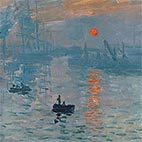
Impressionism and Post-Impressionism Artists Index
Alphabetical Index of the Great Masters of the Impressionism and Post-Impressionism
Impressionism and Post-Impressionism are two important art movements that emerged in the late 19th and early 20th centuries. While they share some similarities, they also have distinct differences in their style, techniques, and philosophy.
Impressionism:
Impressionism originated in France in the 1860s and is characterized by its emphasis on capturing the fleeting moment and the effect of light on color. Impressionist painters often worked outdoors, using loose brushstrokes and vibrant colors to capture the sensory experience of their surroundings. Key artists associated with Impressionism include Claude Monet, Pierre-Auguste Renoir, Edgar Degas, and Berthe Morisot.
Post-Impressionism:
Post-Impressionism emerged in the 1880s and 1890s as a reaction to Impressionism's emphasis on sensory experience and momentary impressions. Post-Impressionist painters sought to express deeper emotions and ideas through their art, using techniques such as bold colors, flattened perspectives, and a more abstract style. Key Post-Impressionist artists include Vincent van Gogh, Paul Cézanne, Paul Gauguin, and Georges Seurat.
Some of the key differences between Impressionism and Post-Impressionism include:
Subject matter: Impressionists focused on capturing everyday scenes and landscapes, while Post-Impressionists often explored more symbolic or abstract themes.
Brushwork: Impressionist paintings are characterized by loose brushwork and a focus on the effect of light on color, while Post-Impressionists often used more deliberate brushwork and flattened perspectives.
Color: Impressionists favored bright, vibrant colors, while Post-Impressionists often used a more bold and expressive color palette.
Philosophy: Impressionism focused on capturing the sensory experience of the world, while Post-Impressionism sought to express deeper emotions and ideas through their art.
Overall, both Impressionism and Post-Impressionism represent important movements in the history of art, and their influence can still be seen in contemporary art today.
Impressionism:
Impressionism originated in France in the 1860s and is characterized by its emphasis on capturing the fleeting moment and the effect of light on color. Impressionist painters often worked outdoors, using loose brushstrokes and vibrant colors to capture the sensory experience of their surroundings. Key artists associated with Impressionism include Claude Monet, Pierre-Auguste Renoir, Edgar Degas, and Berthe Morisot.
Post-Impressionism:
Post-Impressionism emerged in the 1880s and 1890s as a reaction to Impressionism's emphasis on sensory experience and momentary impressions. Post-Impressionist painters sought to express deeper emotions and ideas through their art, using techniques such as bold colors, flattened perspectives, and a more abstract style. Key Post-Impressionist artists include Vincent van Gogh, Paul Cézanne, Paul Gauguin, and Georges Seurat.
Some of the key differences between Impressionism and Post-Impressionism include:
Subject matter: Impressionists focused on capturing everyday scenes and landscapes, while Post-Impressionists often explored more symbolic or abstract themes.
Brushwork: Impressionist paintings are characterized by loose brushwork and a focus on the effect of light on color, while Post-Impressionists often used more deliberate brushwork and flattened perspectives.
Color: Impressionists favored bright, vibrant colors, while Post-Impressionists often used a more bold and expressive color palette.
Philosophy: Impressionism focused on capturing the sensory experience of the world, while Post-Impressionism sought to express deeper emotions and ideas through their art.
Overall, both Impressionism and Post-Impressionism represent important movements in the history of art, and their influence can still be seen in contemporary art today.